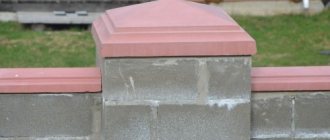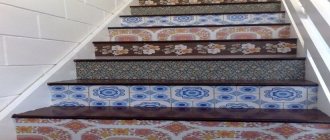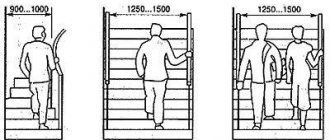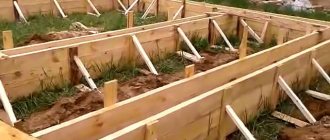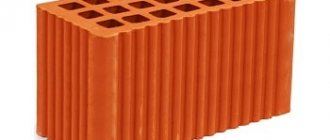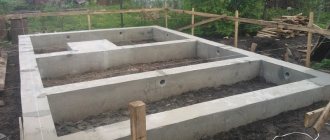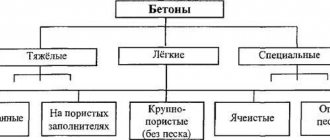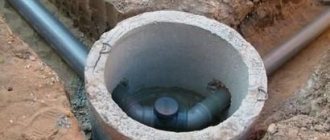Working techniques for installing precast concrete parts in brick buildings
Moving heavy parts manually using mounting crowbars is carried out in three main ways: “with your paw away from you,” for which the pulled end of the crowbar is inserted under the part and the crowbar is pressed away from you onto the part (shown by the arrow). At the same time, the part rises somewhat and, sliding off the paw, moves forward.
If there is a large gap between the part and the base, the “sharp end away from you” technique is used, which is performed in the same way as the “paw away from you”, but the sharp end of a crowbar is placed under the part.
To move to the sides, use the “paw to the side” technique, in which the pulled end of the crowbar is brought under the part at an angle to the nearest vertical edge. By pressing the crowbar in the direction shown by the thick arrow, they lift and move the part, turning the crowbar on the heel of the paw. During the reverse movement, the crowbar is lifted upward and the end of the paw is moved to the initial position, but already at some distance from the first point.
The “paw-on” technique is used to move parts installed in the upper tiers. To perform this technique, place the paw of the crowbar under the part and press the second end of the crowbar down. At the same time, the part is lifted and moved towards the worker.
Rice. 1. Techniques for moving the detail with a mounting crowbar: a - “with your paw away from you”; b - with the sharp end away from you"; c - “paw to the side”; g - “paw on yourself.”
When checking the position of the installed part and correcting it, the following order is observed: - install the base (supporting parts of the part) in place; — check and correct, if necessary, the mark of the top of the part; - bring the side edges of the part to the vertical.
Installation of beams, purlins and lintels over openings.
The installation of purlins (beams, crossbars) begins after the walls are erected. Installation is carried out from scaffolding or from mobile assembly tables. For safety reasons, ladders should not be used.
To mark the position of the purlin (crossbar) in the plan, place the position of the intersection axes on the walls with a theodolite, use a steel tape measure to mark the position of the axes of the remaining purlins (crossbars) and fix them with marks on the wall. Using a meter, an auxiliary mark is applied on the wall near the supporting platform at a distance equal to half the width of the purlin, or crossbar.
The mark of the top of the beam purlin (crossbar) from the alignment is transferred with a mooring or a level to the place of support of each purlin (crossbar) and fixed with a mark on the wall near the socket. For the ridge run, you need to mark and fix with marks on the brick pillar a conventional mark 100 mm below its supporting plane.
Purlins (beams, crossbars) are slung with a two-legged sling. If there is a special crossbeam and sufficient lifting capacity of the crane, several girders are lifted simultaneously.
As a rule, for better distribution of force in a brick wall, a reinforced concrete slab (cushion) whose dimensions are larger than the support platform of the purlin (beam) is laid under the purlin on the butt row of the inner mile. The pillow is placed on the mortar so that the top of the pillow is 8-10 mm below the mark of the bottom edge of the purlin. A mortar bed is arranged under the run, leveling the mortar with a trowel. The top of the bed should be located slightly above the level of the supporting plane of the purlins (crossbars). The area of the bed should be such that after lowering the purlin, the solution is not squeezed out.
Purlins (crossbars) in frame buildings and buildings with an incomplete frame are installed, starting with the lighthouse ones, along the intersectional axes. The installation of these purlins should be checked especially carefully.
Rice. 2. Control over the installation of the sighting run on the auxiliary line: 1 - run; 2 - mortar bed; 3 - reinforced concrete pad; 4 - auxiliary risk.
The correctness of lowering the purlin (crossbar) into place is controlled by sighting along the lateral plane at the auxiliary line (Fig. 100), as well as along the length of the supporting platform. It should be remembered that longitudinal movement of the purlin (crossbar) is prohibited by safety rules.
The correct installation of the purlin (crossbar) is checked along the length of the supporting platform with a meter. An incorrectly installed purlin should be lifted, the mortar bed replaced and reinstalled.
The correct installation of the purlins in height is checked by matching the top of the purlin with the previously applied mark. When aligning purlins (crossbars) installed directly on brick pillars (ridge purlin), measure the distance from the upper plane of the purlin (crossbar) to the auxiliary line with a meter.
A slight settling of the purlin (crossbar) can be achieved by squeezing out the solution when moving the purlin (crossbar) with a mounting crowbar in a horizontal plane across the axis.
The position of the longitudinal axis of the purlin (crossbar) is checked by the coincidence of the middle of the purlin and the axial mark on the wall or column. Possible deviations are eliminated by moving the purlin using a mounting crowbar.
The verticality of the side edges of the purlin is checked with a plumb line “by hand”; deviations are eliminated using a mounting crowbar or a special lever from the ceiling.
In addition, the position of the installed purlin must be additionally controlled by sighting along the top edge at the beacon and previously installed purlins (crossbars) and checked with a template for the distance between the purlins and crossbars. High beams of large spans are temporarily secured with wedges in space with the walls of the nest.
The installation of rafter beams begins after installing the attic floor, laying the cornice and installing the ridge girder, if it is provided for in the project. Installation begins with laying lighthouse beams located along the intersectional axes and carried out in pairs on both slopes.
The beams are slung with a special two-legged sling having branches of different lengths, or by lengthening one of the branches of the two-legged sling with a short sling so that the slope of the beam slightly exceeds the design one.
The beams are laid into place using a crane, starting with the lower end of the beam being placed in place.
If necessary, transverse movements of the beam are carried out using a mounting crowbar in a “paw away” manner, holding the other end of the beam with the crowbar.
Installation of reinforced concrete beam lintels over the openings (Fig. 101) is carried out along the course of the masonry in accordance with the instructions
a mark in order. Lightweight lintels are laid manually or using a crane. When laying lintels, pay attention to the order of laying regular and reinforced lintels, horizontal and vertical edges, sufficient size of the support area in accordance with the design, and that the side surface of the lintel does not extend beyond the plane of the wall.
The installation of floor slabs (flooring) begins after the walls have been erected and the purlins have been laid on the grip. Installation begins from the end walls.
Before laying hollow-core slabs, the voids at their ends are sealed with concrete liners (if they are not sealed at the factory).
The slabs (panels) are slung with a four-leg sling or a universal traverse. Panels “for a room” must be strapped using all mounting loops.
The slabs that are laid first at a distance of at least 2-2.5 m from the wall must be taken and laid from the installation tables, and the rest - from the previously installed floor.
Particular attention is paid to not knocking down the brickwork of the quarter wall, and to the width of the supporting platform, remembering that moving the laid slabs in a direction perpendicular to the supporting structures is not allowed.
Rice. 3. Installation of block lintels: a - bed arrangement; b - manual laying; at the same time, with a crane.
The discrepancy between the width of the supporting platform and the base of the slab is eliminated by re-laying the slab.
When installing narrow slabs of hollow-core flooring, the discrepancy in the size of the mounting sags is determined by sighting along the plane of the ceiling or using a rule. If necessary, settlement of the slab can be achieved by squeezing out the solution during horizontal movements of the slab. The sagging slabs are reinstalled, increasing the thickness of the mortar bed.
The discrepancy in the size of installation seams between adjacent slabs is determined by sighting along the seam; Deviations are eliminated by moving the slab using a mounting crowbar.
If the plane of the slab has a curvature, it is laid in places where it adjoins walls or partitions so that the free edge is horizontal.
A slab with a sagging middle is laid on a thick bed so that adjacent slabs divide the sag in half.
Slabs (panels) can be unslinged only after the alignment has been completed.
The seams between the slabs immediately after laying the slabs are sealed with mortar, feeding it with a shovel and compacting it with a trowel.
A temporary inventory fence is installed around the mounted part of the ceiling.
The installation of attic roof coverings begins after laying the cornice and installing at least 4-6 pairs of rafter beams.
Before installing the covering slabs (panels), the attic floor must be supplied with hydro- and thermal insulation materials provided for by the project.
Installation begins with the laying of lighthouse slabs and is carried out alternately on one or the other roof slope. The end of the slab at the outer wall is accepted by the link, standing on the ceiling, and the installer accepts the slab at the ridge from the assembly table.
When covering the roof with ribbed slabs, the marks of intersectional axes on the eaves are used. Using a steel tape measure, the joints between the slabs are marked on the cornice and purlin, and after laying the lighthouse slabs, the mooring is pulled at the level of the top of the end rib of the end of the slab resting on the cornice.
When covering with rolled panels (shells), marks mark the middle of the rafter beams.
Slabs and rolled panels of attic roofs are slung with a universal traverse or a special four-leg sling and supplied for installation with an inclination slightly greater than the design one, so that the slab (panel) rests first with its lower end.
The correctness of lowering the slabs (panels) into place is controlled by risks, the size of the installation gap between the laid and previously laid slabs (panels) and the mooring (for ribbed slabs). Particular attention should be paid to the width of the support area, since moving laid ribbed slabs along and shells across the slope is not allowed.
The installation of balcony slabs along the entire length of the grip begins only after the walls have been erected and the ceiling has been laid above the underlying floor. Installation should begin with the installation of beacon plates along the edges of the grip.
For balconies on the second floor, use a meter to mark and mark the position of the balcony slab with marks. On subsequent floors, the position of the marks is additionally controlled along the balcony of the underlying floor, using a plumb line for this.
After installing the lighthouse slabs, it is necessary to pull the wire mooring along their outer upper edge along the length of the entire grip.
The slabs are slung with a four-legged sling or served in a traverse container.
The mortar bed is made by leveling it with a trowel and not bringing the bed 2-3 cm to the edge of the wall.
The correct lowering of the slab is controlled by risks and mooring.
The slab should be laid horizontally or with a slight slope towards the free end. Temporary fastenings should be installed immediately after laying the slab.
When the balcony door is located on the side, for temporary fastening it is necessary to use racks installed on the balcony or masonry of the underlying floor. If the door is located in the middle of the panel, then the slab is secured using a stand with guy wires. To do this, the rack is installed on the ceiling, the guy ropes are secured to the mounting loops of the slabs, they are put on the side of the balcony slab, the rod is secured with a pin and, by rotating the nut, the rod is tightened.
Rice. 3. Lifting balcony slabs with a container traverse.
The correct installation of the slab is checked by the risks and mooring, as well as by sighting on the lighthouse and previously installed slabs. Deviations are eliminated by moving the slab using a mounting crowbar.
The horizontal installation of the slab is checked by laying a straight line with a level in two perpendicular directions. If there is a slope in the longitudinal direction, it is necessary to lay the slab again, changing the thickness of the mortar bed. The slope towards the building is eliminated by rotating the nut of the posts.
Temporary fastenings can only be removed after laying the walls of the next floor.
The installation of staircase landings begins after the walls of the staircase have been erected to the level of the landings and is carried out during the construction of the walls.
The platform is slung with a four-leg sling or a universal traverse and delivered to the laying site in a horizontal position.
The mortar bed is arranged by feeding the mortar with a shovel and leveling it with a trowel. The surface of the bed should be 3-5 mm above the design level of the bottom of the platform.
The platform at the floor level must be laid in place from the ceiling, and the intermediate platform must be laid from scaffolding installed in the rooms adjacent to the staircase.
Rice. 4. Temporary fastenings of the balcony slab: a - resting on the masonry of the lower floor; b - stand on guys.
The correct height of the platform is controlled by risks, and horizontality is controlled by setting a level with a level in two mutually perpendicular directions. Possible deviations are eliminated by changing the thickness of the mortar bed and re-laying the platform.
The correct laying of the platform should also be monitored by the size of the installation gap with the adjacent wall and a special template in two places (at the support points of the flight stringers).
If necessary, the platform is moved using a mounting crowbar.
Flights of stairs are slung with a special sling and delivered to the laying site in a position close to the design one, with slight (up to 10 cm) excesses of the upper end of the flight, thereby ensuring that the lower end of the flight is first supported, and then the upper. In the absence of embedded mounting loops, loops made from a cable or clamp are used for slinging.
To receive a flight of stairs, the manager is located on the lower landing, and the installer is located on the ceiling or upper landing.
When laying the march in place, lower the lower end of the march onto the platform and press the march against the wall; lower the upper end of the march and loosen the slings. After this, the position of the march and the platform is checked.
If necessary, you should raise the upper end of the flight and, using the “paw away” technique, move the flight or platform slightly, increasing or decreasing the mounting clearance with the wall.
After alignment, the installer seals the march with mortar, first thoroughly clearing the seam of debris, snow, etc. Using a shovel bucket, lay a bed of mortar along the length of the joint and thoroughly compact it with a trowel.
After completing the installation of the march and platform, temporary or permanent fences are immediately installed.
Rice. 5. Scheme of installation of a flight of stairs using a special traverse: 1- traverse; 2 — installed march; 3 - previously established march.
— Working techniques for installing precast concrete parts in brick buildings
Reinforced concrete purlins PRG are manufactured in accordance with series 1.225-2, designed for covering openings in the walls of public buildings and administrative buildings made of brick or wall blocks and designed for a design pressure of 4000 kgf/m, i.e. used in load-bearing walls with the ability to support both PC floor slabs and overlying masonry.
They are made of heavy concrete grade M-250 for compression, and for 6-meter ones - M-350. Reinforcement is possible in 2 options: prestressed, reinforced with prestressed reinforcing bars of the AtV brand and spatial frames and unstressed, reinforced only with spatial steel frames. Most often they are produced unstressed, i.e. with conventional reinforcement
Since the load of the overlying wall is quite large, and the surface area on which the purlin presses is quite small, it is recommended to use support slabs as linings during construction, which allow the load to be distributed over a larger surface.
The standard length of the product provided by the series can be 2.8; 3.2; 3.6; 4.2; 4.8; 5.4 and 6 meters. However, it is possible to produce reinforced concrete purlins and intermediate sizes upon request.
Installation of horizontal beams in house construction
In most cases, solid or laminated timber is used as a bench, although in some cases sanded or rounded logs are used. In any case, the rules for installing such beams are subject to the general principles of building construction.
How to calculate and check right angles
The right angle is determined on the construction site at the site of laying the foundation - in accordance with it, the general perimeter of the building will be set. You can get a junction of two lines of this type without complex instruments, using a cord (cotton thread that does not stretch), pegs and a metric tape measure. But here you should be careful - the more accurately the dimensions are set, the better the geometry of the foundation will be.
Method for determining right angle
Please note the drawing above:
- at point B, a peg is driven into the ground and a cord is tied to it, the other end of which is taken to point A or point C, at 3m or 4m, respectively;
- for known reasons, the extended segment must turn out to be parallel either to the neighboring site or to the street, so that the constructed building fits symmetrically into the exterior;
- in a similar way, stretch the second piece of cord at an angle to the first - in this case, stretch one piece exactly by 3 m, and the second by exactly 4 m;
- if the ends A and C are separated from each other by exactly 5 m, driving pegs there, then the angle ABC will turn out to be right, at 90ᵒ, and the quadrangle for laying the foundation will be marked relative to this calculation.
Checking the foundation and piping
The length of each side of the base is set in accordance with the project - the perimeter that the house under construction will have. When the pegs are driven in at the four corners, the geometry is checked again - the diagonals must exactly coincide with each other (error tolerance ± 1-2 mm). If the diagonals do not coincide, the angles are measured again and the evenness of the perimeter lines is checked.
Checking the diagonals of the bottom trim
If the house involves any extensions standing on the same foundation, then the marking is carried out in a similar way, then the joints of the beam will have right angles. In such cases, the roofs turn out to be complex (multi-slope) and the slightest failure on the foundation will directly affect their geometry.
Even if, when laying the foundation, there was a slight deviation regarding the angles, and there was a deviation of several degrees, the situation can be corrected with the help of strapping. If for a finished foundation an error of ±20mm can be allowed, then for piping only ±3-5mm. With the help of these planks, a geometrically regular rectangle is assembled, and the perimeter of the entire building also turns out to be regular (rectangular).
Calculation of horizontal beams for ceiling and roof
If the floor between floors is made of wooden beams, or beams, which carry the loads of furniture and racks supporting the ceiling, then the distance between them and their cross-section is determined by the length of the span - this is the length of the beam (log) resting on the opposite walls. For example, for beams with a length of 5m and a cross-section of 125×200mm, a step of 60cm is set, but if the cross-section increases to 150×225mm, then the step will already be 100cm. All calculations are in the table.
Calculation table for wooden floor beams
If we talk about choosing the section of the beam for the ceiling (the beam is suspended), then the strongest profile will be 5 to 7. This means that the beam should have 7 measures in height, and 5 in width, for example, if the height is 200 mm (200/ 7=28.5), then the width needed is 28.5*5=142.5mm. But such sections do not exist, so the closest values are selected, where in any case the height is greater than the width.
These calculations are needed so that under vertical load the deflection of horizontal beams is minimal, and the permissible deflection is 1/200-1/300 of the length. It turns out that a five-meter bench in a suspended state under a vertical load can bend by 1.5-2 cm. When installing such ceilings, the beams are hemmed in the form of an arch and after some time they are fixed in a strictly horizontal position, taking into account the deflection.
Another way to calculate the sectional height of suspended beds is to relate their length and sectional height using the 1/25 principle. That is, the vertical section of a five-meter beam should be 5/25 = 0.2 m, but its width will already be selected in accordance with the pitch. These calculations are also relevant for the attic - there may also be vertical loads from any stored items and the roofing system.
For the mauerlat or over the ceiling, the beams can be thinner, since they lie on a plane. But if the roof does not have a mauerlat, then instead the rafters are attached to the top frame, and fixed to each other with beams, which at the same time serve as the basis for supporting the racks under the rafters.
Some installation nuances
Construction of a gable rafter system
If floor beams do not serve as support for a higher structure, then they are usually not perceived as substructures, although they are such in their essence. Here, the profiles that are placed on top of the ceiling and serve as a support for the rafter system are called “beddings”.
Their number depends on the expected load on the roof (mass of snow and wind) - that is, it can be one beam that runs under the ridge, one or two beams on opposite sides of the ridge, or jumpers between the rafter legs. The cross-section of the beam (log) in such cases is selected in accordance with the cross-section of the rafters - it is desirable that it is not smaller.
Assembling rafters on the ground
The top photo shows how the rafters are assembled on the ground, temporarily connecting them together so that all the triangles exactly match each other. Here the lower lintel will lie flat, since it will lie on the plane of the ceiling. This name determines the presence of racks for supporting the rafter legs.
Linings are used for leveling and ventilation
The beds are also installed on concrete floors, which do not always create a single, flat plane. Therefore, to level these beams, pads (plastic, metal, wood) are used, which also help create a ventilation gap. If the attic ventilation is insufficient, this gap will increase the service life of the profile, since natural air circulation will dry it out.
To summarize, it should be noted that the beds do not always rest on a plane along their entire length - in some cases, their role is played by floor (floor) beams. These are, of course, simplified designs, but, nevertheless, they perform their function.
Marking
The marking consists of alphanumeric groups separated by a hyphen:
- The 1st group contains the designation of the PRG type - rectangular purlin and overall dimensions (length, width, height in dm.).
- Group 2 includes the design load without taking into account its own weight (in tons/m) and the class of reinforcement used.
For example, PRG 32.1.4-4AtV - a rectangular girder with a length of 3180 mm, a width of 120 mm, a height of 400 mm under a design load without taking into account its own weight of 39.2 kN/m (4 tn/m), reinforced with AtV steel, i.e. . pre-stressed.
Video: installing a roof deck
Thematic materials:
The city of Tours is a bourgeois city in France The city of Tours in France attractions The city of Tours: attractions, hotels, restaurants Tours a city in France Rumelihisar fortress - an outpost of the conquest of Constantinople by the Ottoman army New Year in the Maldives 4 Crete Who invented the fountain and other interesting facts Features of the hotel base Travel to Nepal Everest is listed as a UNESCO World Heritage Travel in Nepal Everest is listed as a UNESCO World Heritage
103583
If you notice an error, select a piece of text and press Ctrl+Enter
Dimensions and support
| Dimensions | Max opening width | Min support | Load kgf/m | |||
| Length | Width | Height | ||||
| PRG28.1,3-4 | 2780 | 120 | 300 | 2420 | 180 | 4000 |
| PRG32.1,4-4 | 3180 | 120 | 400 | 2820 | 180 | 4000 |
| PRG36.1,4-4 | 3580 | 120 | 400 | 3220 | 180 | 4000 |
| PRG42.2,5-4 | 4180 | 200 | 500 | 3780 | 200 | 4000 |
| PRG48.2,5-4 | 4780 | 200 | 500 | 4380 | 200 | 4000 |
| PRG54.2,5-4 | 5380 | 200 | 500 | 4980 | 200 | 4000 |
| PRG60.2,5-4 | 5980 | 200 | 500 | 5580 | 200 | 4000 |
A purlin in roof construction is a horizontally placed beam between the supporting structure and the roof sheathing. Its key functions are transferring the load from the roofing covering, its uniform distribution in the rafter system, and also ensuring the rigidity of the sheathing.
Purlins are made of wood, steel and reinforced concrete and are used in the construction of roofs of industrial buildings and private houses. They are also installed as bases for floor slabs and to strengthen openings.
Purlin in the rafter system
Roofing and construction beams
Before starting construction, study the types of beams to get an idea of how the roof works. Each beam has its own purpose and occupies a certain place in the floor system.
Roof crossbars are made from metal, solid wood or lamellas glued together. Bent-laminated beams are manufactured in accordance with GOST. They are easy to work with, are little affected by weather conditions and are used to increase the intervals between runs. The cross-section of the elements can be rectangular, T-shaped or I-beam. The I-beam shape (H) guarantees the rigidity of the beam and reduces the bending moment to almost zero.
Scheme of a broken roof with a purlin
Types of wooden construction beams in a roof support system:
- Mauerlat - a square beam laid on the walls to support the rafters;
- ridge - support beam at the top of the roof;
- rafter beam - forms the angle of the roof;
- tightening and crossbar - connect the rafters of opposite slopes;
- filly - extends the rafters, forming a roof overhang;
- strut - located at an angle to the vertical elements and supports the rafters;
- run.
Scheme of lathing from wooden elements
The purlins are fixed on supports at a distance of 4-5 meters from the ridge, and expansion supports are placed between them. If you need to lengthen the rafters, the joint is placed above the purlin.
Structure and types of metal beams for roofs:
- bottom belt
- upper belt
- lattice.
The lattice is assembled from racks and braces and attached to the belts on both sides using shaped elements.
Types of purlins for roofing
Purlin supports are classified by location in the roof slab system, as well as by shape and material.
Types according to the place of application in the rafter system
There are three types of purlin supports - side, ridge and mauerlat.
The ridge purlin is the highest beam of the roof; it is installed in the upper parts of the gable walls, and the edges are wrapped with waterproof material. If necessary, the structure is reinforced with racks. The rafters rest on the ridge with their upper end.
Ridge fixed in the gables of the walls
Mauerlat or matitsa is a thick beam with a cross-section of 150x150 mm, which is laid on load-bearing walls parallel to the ridge in order to equally distribute the load from the roof. The Mauerlat boards are called the roof foundation and are firmly secured with anchor bolts to the walls, having previously laid down waterproofing material. In brick buildings, the matrix is installed in a pre-prepared armored belt made of reinforced concrete on reinforcement.
Mauerlat laid on a concrete wall on top of waterproofing material
The side purlin connects the rafters in the middle - with its help they strengthen the roof, reducing the bending load of the rafters. To transfer the load to the floor, vertical posts are installed under the side girders.
Classification of beams by material
As mentioned above, according to the material, purlin supports are classified into reinforced concrete, metal and wood. Metal purlins are manufactured industrially and can be uniform or lattice. The first ones are made from channels and I-beams - they are easy to manufacture and install, and cost 10% less than lattice ones. The disadvantage of grid purlins is their high cost and a large number of complex node elements. The advantage is light weight.
Runs can be:
- whole;
- compound.
Composite beams are used when it is necessary to cover a large area of the roof to avoid distortion from bending loads.
Categories of wooden supports by design
Structurally, purlins are classified into:
- continuous;
- split;
- with struts;
- cantilever-beam;
- with support beams.
Split ones are rows of wooden supports fixed to the roof slopes and supported by supporting structures - racks. Often secured with struts and struts.
Scheme of cantilever-beam and continuous purlins
Cantilever-beams are enfilade rows of boards less than 6.5 m long, the joints of which are located outside the support beams. In this case, two consoles are formed in the middle gaps, and one in the extreme gaps. Cantilever beams are used in the construction of roofs with a pitch of load-bearing structures of up to 4-5 m.
Continuous purlins are suitable for roofs with a slope of up to 15° and covered with lightweight materials - roofing felt or flexible tiles. With a greater slope, thin beams cannot withstand bending loads and break.
To strengthen the structure in construction, struts and beams are used:
- A support beam is a small block mounted on a support post. The supporting beam of the sheathing rests on it.
- A strut is an inclined beam that supports horizontal beams and works in compression.
The struts contribute to the uniform redistribution of loads from the coating to the supporting elements.
Grouping of reinforced concrete purlins by profile
Purlins made of reinforced concrete are marked according to their cross-sectional shape and load. The cross-sections of the purlins are:
- T-bars;
- rectangular.
Rectangular reinforced concrete block
T-type beams are divided into two more groups:
- beams with metal perpendicularly attached to the ribs of the purlin - installed on roofs with a slope of up to 25%;
- supports that can withstand a roof slope of more than 25%.
T-bar supports are used in the construction of roofs of large-area unheated premises, as well as in seismically active regions. They can withstand sub-zero temperatures down to -50°C. A key feature of T-bar reinforced concrete supports is the presence of holes for hooks and other gripping devices, ensuring ease of installation.
Rectangular supports are tall and thin-walled, strong due to the bends. They are classified into solid and lattice.
Gradation of metal components by profile
Solid metal purlins are bent profile beams of several types:
- C-shaped;
- I-beam;
- Z-shaped;
- T-bar;
- channel
The T-profile in cross-section resembles the letter T, the I-beam - H, and the channel - the letter P.
Types of metal beams with lattice profile:
- rod-truss with a lower chord and a round steel grille;
- three-panel.
The three-panel girder is accepted as standard due to the smaller number of components and ease of manufacture. The upper chord of the beam is made of double channels, and the lattice is made of curved single channels.
Reinforced concrete purlins
Home ⁄ Reinforced concrete purlins
Reinforced concrete purlins are manufactured exclusively in factory conditions using special high-performance equipment. Only if the specified conditions are met, it is possible to achieve strict compliance with their mass production of the dimensions required by the design documentation, an effective method of reinforcement and rational cross-sectional shapes at an optimal production cost.
Call
Opening hours Mon-Fri from 09.00 - 18.00 without breaks. The office is closed on Saturday, Sunday and holidays. By agreement we can ship on Saturday.
| Nomenclature | Price | Volume (m3) | Weight, kg) | Dimensions (mm) |
| PRG-10 | 8 410 | |||
| PRG-11 | 11 438 | |||
| PRG-17-1.3-4t | 2 016 | 0,061 | 150 | 1700 x 120 x 300 |
| PRG-20-1.3-4t | 2 339 | 0,072 | 180 | 2000 x 120 x 300 |
| PRG-21-1.3-4t | 2 370 | 0,075 | 190 | 2080x 120 x 300 |
| PRG-22-1.3-4t | 2 465 | 0,079 | 200 | 2200 x 120 x 300 |
| PRG-24-1.3-4t | 2 562 | 0,086 | 215 | 2380 x 120 x 300 |
| PRG-24-1.4-4t | 3 219 | 0,12 | 300 | 2400 x 120 x 400 |
| PRG-25-1,3-4 | 2 678 | 0,09 | 225 | 2500 x 120 x 300 |
| PRG-27-1.3-4t | 3 321 | 0,097 | 240 | 2700 x 120 x 300 |
| PRG-28-1,3-4АIII | 3 321 | |||
| PRG-28-1.3-4t | 3 339 | 0,1 | 250 | 2780 x 120 x 300 |
| PRG-30-1.4-4t | 3 374 | 0,144 | 360 | 3000 x 120 x 400 |
| PRG-31-1.4-4t | 3 400 | |||
| PRG-32-1.4-4t | 3 427 | 0,15 | 380 | 3180 x 120 x 400 |
| PRG-33-1.4-4t | 3 449 | 0,158 | 400 | 3300 x 120 x 400 |
| PRG-34-1.4-4t | 3 524 | 0,163 | 410 | 3400 x 120 x 400 |
| PRG-35-1.4-4t | 3 658 | 0,168 | 420 | 3500 x 120 x 400 |
| PRG-36-1.4-4t | 3 721 | 0,17 | 430 | 3580 x 120 x 400 |
| PRG-37-2.5-4t | 8 027 | 0,37 | 930 | 3700 x 200 x 500 |
| PRG-38-2.5-4 | 8 060 | 0,38 | 950 | 3800 x 200 x 500 |
| PRG-39-2.5-4t | 8 115 | 0,39 | 980 | 3900 x 200 x 500 |
| PRG-40-2.5-4t | 8 172 | 0,4 | 1000 | 4000 x 200 x 500 |
| PRG-41-2.5-4t | 8 398 | 0,41 | 1030 | 4100 x 200 x 500 |
| PRG-42-2.5-4t | 8 471 | 0,42 | 1050 | 4200 x 200 x 500 |
| PRG-43-2.5-4 | 8 888 | 0,43 | 1080 | 4300 x 200 x 500 |
| PRG-44-2.5-4t | 9 034 | 0,44 | 1100 | 4400 x 200 x 500 |
| PRG-45-2.5-4t | 9 255 | 0,45 | 1130 | 4500 x 200 x 500 |
| PRG-46-2.5-4t | 10 518 | 0,46 | 1150 | 4600 x 200 x 500 |
| PRG-47-2.5-4 | 10 747 | 0,47 | 1180 | 4700 x 200 x 500 |
| PRG-48-2.5-4t | 10 970 | 0,48 | 1200 | 4800 x 200 x 500 |
| PRG-49-2.5-4t | 11 429 | 0,49 | 1230 | 4900 x 200 x 500 |
| PRG-50-2.5-4t | 12 118 | 0,5 | 1250 | 5000 x 200 x 500 |
| PRG-51-2.5-4t | 12 294 | 0,51 | 1280 | 5100 x 200 x 500 |
| PRG-52-2.5-4t | 12 500 | 0,52 | 1300 | 5200 x 200 x 500 |
| PRG-53-2,5-4 | 12 884 | 0,53 | 1330 | 5300 x 200 x 500 |
| PRG-54-2.5-4t | 12 951 | 0,54 | 1350 | 5400 x 200 x 500 |
| PRG-55-2.5-4t | 12 999 | 0,55 | 1380 | 5500 x 200 x 500 |
| PRG-56-2.5-4t | 13 037 | 0,56 | 1400 | 5600 x 200 x 500 |
| PRG-57-2.5-4t | 13 092 | 0,57 | 1430 | 5700 x 200 x 500 |
| PRG-58-2.5-4t | 13 136 | 0,58 | 1450 | 5800 x 200 x 500 |
| PRG-60-2.5-4t | 13 275 | 0,6 | 1500 | 5980 x 200 x 500 |
Since Soviet times, reinforced concrete purlins have been and remain to this day a very popular building element. We offer a full range of reinforced concrete products that meet all modern regulatory requirements in construction.
Production Features
At the moment, the production of purlins is carried out using several methods.
In conveyor production, reinforced concrete purlins are manufactured in forms placed on trolleys, which are moved from one production area to another to perform the necessary technical operations:
- laying reinforcement cages; - tensioning reinforcement at pre-stressed elements; - if the technical specifications provide for the presence of installation and transportation voids, then installation of void-forming liners; - laying and compacting the concrete mixture; - removal of void-forming liners;
— if accelerated hardening of concrete is required, then reinforced concrete purlins are subjected to thermal and damp treatment.
- Flow-aggregate method.
With this production method, purlins are manufactured in different factory workshops, and the purlins are transported between them using cranes. With this production method, there is no strict connection to the production rhythm, and therefore the enterprise can produce several types of runs at once.
Its peculiarity is that the stands responsible for the necessary technological operations move along fixed reinforced concrete girders. The stands are equipped with vibrators, concrete spreaders and mobile cranes, which are responsible for moving them around the production area. This production method is usually used for the production of purlins with prestressed reinforcement elements.
Design features of reinforced concrete purlins
Reinforced concrete purlins, the dimensions of which are established by the current GOST and design documentation, are made of heavy concrete using prestressed reinforcement and reinforcement without prestressing.
What is prestressed reinforcement? This means that before the workpiece is poured with concrete mixture, a significant compressive stress is artificially created on the reinforcement in areas where it will experience significant stretching during use of the purlin. This achieves an increase in the crack resistance of the purlin, an increase in the service life, and a reduction in its cost by saving metal for the reinforcement.
In general, it is forbidden to use high-strength steel for reinforcement without prestressing it, since this will lead to the appearance of cracks in tension zones and deprive the building of the required performance qualities.
In addition, prestressed reinforced concrete purlin has better characteristics in terms of durability, rigidity, corrosion resistance and resistance to dynamic loads. Therefore, only such a run is used in the construction of buildings that are characterized by regular exposure to high air temperatures (up to +50 degrees) and slightly or moderately aggressive gas mixtures.
Marking of reinforced concrete purlins
Reinforced concrete purlins GOST 26992-86 are marked with several groups of letters and numbers.
The first group reports the type of purlin, dimensions, rounded to the nearest decimeter. For example, a purlin of a rectangular cross-section with overall dimensions of 3180x120x400 in the technical documentation will be marked as PRG 31.1.4. A purlin with a flange perpendicular to the section edge is marked as PR, and a monolithic purlin is marked as P.
The second group is the class of reinforcement and the digital designation of the design load, which does not take into account the own weight of the run. Expressed in tons per meter.
A few words about the class of fittings. There are six of them - from class A-1 to A-6. The higher its class, the higher, accordingly, its strength. All reinforcement, with the exception of class A-1, is hot-rolled rod with a periodic profile. In addition, in order to increase its strength, the reinforcement is subjected to thermal or thermomechanical treatment. In this case, a small letter T is added to the letter A, for example, At-3 - this is third-class fittings that have undergone thermomechanical treatment.
Finally, the third alphanumeric group reflects certain design features of the run. In particular, the concrete used in the manufacture of purlins is marked here:
P – reduced permeability; N – normal permeability.
Technical requirements for reinforced concrete girders
- Reinforced concrete purlins, their dimensions and weight, and grade of concrete for compression must comply with GOST 26992-86, as well as the requirements of design documentation for the specific building being constructed.
- Reinforced concrete purlins are made exclusively from heavy concrete grades in the density range of 2200-2500 kg/m3.
- Purlins are supplied to the consumer with surfaces prepared for painting or plastering.
- They must meet the requirements for resistance to loads, the occurrence of cracks, rigidity and strength, which are imposed on them by the technical conditions of the building being constructed.
The physical characteristics and requirements for the production of reinforced concrete purlins are also determined by GOST 13015.0. In particular, it defines:
- shapes of various types of purlins; - permissible deviations in the thickness of the protective layer between the reinforcement and the outer surface of the purlin; - conditions for using certain grades of steel depending on the physical and chemical characteristics of the operation of the purlins; - position, shape and size of the used embedded and reinforcing products; - the quality of the materials used to prepare the concrete mixture, from which, in fact, the run was made; - the level of frost resistance; - the level of moisture resistance; - the level of resistance to various aggressive gas environments; - the level of concrete strength;
— concrete hardness level.
Rules for acceptance of reinforced concrete purlins
When accepting a batch of reinforced concrete purlins, you should pay attention to the following indicators and characteristics:
- do the brand and class of concrete in the purlins of the batch sent to you correspond to the declared ones? - does the strength of the welded joints meet the requirements of the design documentation, are their geometric parameters met? - is the thickness of the protective layer from the reinforcement to the surface layer of the product sufficient?
— Do the dimensions of the technological openings comply with the requirements of regulatory documentation?
To obtain comprehensive answers to all these questions, a series of acceptance tests is carried out. If the tests reveal defects, then such reinforced concrete purlins, the price of which will remain unchanged, must be returned to the manufacturer until the identified defects are eliminated.
Use of reinforced concrete purlins in construction
Reinforced concrete purlins are actively used in the construction of buildings for various purposes: residential, industrial, warehouse and agricultural. Their functional purpose is to take on the load-bearing load of floor slabs. Therefore, despite the fact that several decades have passed since the adoption of the standard for the production of reinforced concrete slabs, despite the fact that construction technologies have undergone a significant improvement, the use of reinforced concrete purlins still remains relevant in modern construction, including due to their reliability and high strength.
In addition to their main purpose, reinforced concrete purlins are also used as supporting elements for door and window floors. To strengthen the technological niches in the building structure, additional upper-level slabs are installed on them; they can also be used as part of the reinforcing or truss structure of the trusses. In other words, these structures play a very important role during the construction of various building structures - the role of additional reinforcing horizontal beams.
If you are interested in these or any other reinforced concrete products, please contact our company! If any questions arise, our specialists will provide comprehensive answers to any topic related to reinforced concrete structures.
mdm-gbi.ru
Labeling of industrial products
Purlins in construction are critical structures; they are manufactured in strict accordance with GOST and marked. To select beams that correspond to the purpose of the roof, you need to be guided by the product labeling.
Reinforced concrete blocks for roofing
Reinforced concrete purlins are marked with letters and numbers, including information about the dimensions and support load of the products. The letters indicate the series and design features of the purlin:
- PR – T-shaped beam with a side;
- P – one-piece purlin;
- PRG – support of rectangular section.
The numbers indicate the length, width and height of the purlin, and the latter indicates the load that it can withstand, in tons. The marking may also include values about the reinforcement of the product. Purlins can be unstressed, reinforced with a steel frame or prestressed, with additional longitudinal reinforcement bars to increase the load-bearing capacity.
Product dimensions are taken into account when marking
Also in the production of reinforced concrete structures the following markings are used:
- 1PR – for flat roofs with reinforcement without reinforcement;
- 2PR – for flat roofs with reinforced reinforcement;
- 3PR – for structures with a slope of up to 5%;
- 4PR – for roofs with a slope of up to 25%;
- 5PR – with a diagonal shelf for steep roofs.
An example of marking a reinforced concrete purlin with decoding: PRG 48-2-5-4tAIII-1. This is a girder with a rectangular cross-section with dimensions of 4800x200x500 mm and a permissible load of 4 tons. It is pre-stressed and reinforced with additional reinforcement. Suitable for the construction of heated and unheated critical structures in areas with bad weather conditions and seismically active areas.
Metal roof elements
Metal beams are marked by profile, design, material and dimensions.
Classification and marking of I-beams:
- Ш – with a wide shelf;
- K – columnar;
- B – ordinary.
The number before the letter indicates the conditional height of the beam in mm, the remaining dimensions are selected in accordance with GOST. For example, for support 30B1 the height is 296 mm, and the letter “B” denotes a normal beam. The dimensions of the beams are in the range of 10-100 mm.
Production of hot rolled purlins
Metal beams for purlins are made of steel by welding or hot rolling - for each manufacturing method, GOST is provided, which describes the marking of products.
Reinforced concrete purlins
In the construction industry, various types of reinforced concrete products are used, which ensure the strength of the entire structure. Many of them, for example, some types of floor slabs, piles, rings and a number of others, can be constructed directly on the construction site. The production of reinforced concrete purlins is possible only industrially and exclusively using “heavy” concrete. As a rule, M200 or M300.
In terms of their structure, these building materials are not much different from reinforced concrete pillars - both have the same structure. In essence, this is a structure consisting of a reinforcement frame and hardened concrete mortar. But what are reinforced concrete purlins? Their peculiarity is that they are characterized by greater mass, length and increased fracture strength, and therefore are used as supports during the installation (laying) of other structural elements, for example, slabs. Moreover, their production is not just put on stream - the technology provides for the production of products under a strictly defined load.
Marking
For product specifications, alphabetic and numerical designations are used, which are divided into groups.
First. Contains information about the type of purlin and its dimensions. All linear dimensions are rounded to the nearest “dm”.
- P – monolithic.
- PR – the presence of a “shelf” parallel to the longitudinal axis of the product or at an angle to it (“oblique”).
- PRG – with a rectangular profile.
An example of the designation of a PRG purlin with dimensions 2,200 x 120 x 300 - PRG 22.1.3. But this is typical for technical documentation, since products are sold with dimensions indicated in “mm” in the price lists.
Second. Characterizes the reinforcement class and design load (t/m).
Third. Information about the specifics of the run, including the characteristics of the concrete used.
- N – normal permeability.
- P – reduced.
Dimensions
Each brand of such long beams is characterized by its linear dimensions, which vary in ranges (in “cm”):
- in length – 278 or more;
- width – up to 40;
- in height – up to 50.
Weight – from 150 kg to 1.5 tons.
Product varieties
1. Reinforced concrete purlins of rectangular section.
A special feature is that their installation is accompanied by additional measures. The fact is that for some types of purlins the difference in the sides of the profile rectangle is quite significant, so the reliability of their fastening at the place of installation can sharply decrease. For reliable fixation, special elements called “bends” are used.
Such long beams are available with a solid or lattice cross-section. The latter version is lighter in weight, therefore more universal in use (but installation is carried out at intervals not exceeding 6 m). But, for example, PR brand products are much less common.
2. T-section purlins.
The most commonly used material. Excellent for installation and operation in earthquake-prone regions (up to 7 points), in low temperature conditions (down to -50 °C). Suitable for both heated and unheated buildings, they are resistant to aggressive environments.
- 1PR – with non-tensioned reinforcement.
- 2PR - with tension.
- 3PR - the same, but for structures with a slope of 5% or less.
- 4PR and 5PR - with diagonal “shelves”. Used for slopes of no more than 25%.
All purlins have special holes (50 mm) for attaching slings if it is necessary to move products.
Application of purlins
The brand of prefabricated reinforced concrete purlins is selected depending on the specifics of installation and subsequent operating conditions. All initial data are displayed in the design documentation. They are used for various purposes:
- as a basis for laying floor slabs;
- when arranging various openings as an upper horizontal “stop”;
- to strengthen rafter systems, trusses, technological niches, as well as in a number of other cases when it is necessary to strengthen the structure being built.
Installation of purlins is carried out by several workers (3 – 4).
Pricing
The cost is mainly determined by the linear dimensions and grade of concrete used. When calculating it, the specifics of the reinforcement and the special properties of the products are also taken into account. The range of products is huge, so if you need to buy construction purlins, you need to focus on the approximate price range from 1,860 to 11,250 rubles/piece.
To have a more detailed idea of the cost of runs, it is enough to familiarize yourself with the data on some types of products:
| Designation | Cost (rub/piece) | Linear dimensions (mm) |
| PRG 12-1-4 | 1 890 | 1,200 x 120 x 400 |
| PRG 30-1-4 | 3 495 | 3,000 x 120 x 400 |
| PRG 58-2,5-4 | 10 988 | 5,800 x 200 x 500 |
Detailed information on the entire range of building materials of this type produced in Russia can be found in GOST No. 26992/1986.
hardstones.com
